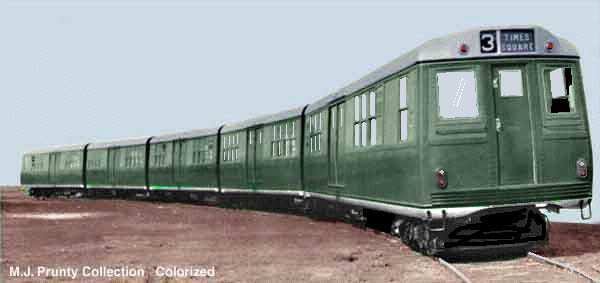
New York's Lost Transit Legacy Page 2

The Green
Hornet, built by Pullman. This unit lasted the shortest
time of any of the BMT's experimental cars. It was requisitioned for its aluminum content during World War II.
Color photos of the Green Hornet are very hard to come by.
This builder's view has been colorized.
M.J. Prunbty Collection. Colorized by Paul Samuels.
The BRT was the fly in the ointment of the IRT's monopoly hopes, leading to the Dual Contracts of 1913, under which the BRT, IRT and the City shared the costs of building and equipping additional subway and elevated lines and modernizing existing lines. Once the BRT (which became the BMT in 1923) emerged from its Brooklyn cocoon with its partnership with the City, it looked for ways to expand and improve its system and equipment.
The last system, the IND, a noble venture in concept, was founded out of the political machinations of John F. Hylan, Mayor of New York from 1918 to 1925. Hylan made bashing "the traction [transit] interests," meaning primarily the IRT and BRT, a centerpiece of his mayoralty. In so doing, he politicized transportation and the fare in a manner still highly visible today. An important part of his thesis was that uncaring private interests were profiting mightily from the nickels of New York straphangers, money that deserved to be in the pockets of the City, as the people's representative.
Hylan's Special Corporation Counsel, Harry A. Gordon, expressed the City's anger at this presumed private sector thievery this way: "Unbelievable as it may seem the City of New York [...] is chained, to a partnership with the traction companies through the betrayal of the City's interests, by the outrageous Dual Contracts of 1913."
It might amuse the modern
New Yorker to realize that, back in 1925, the City saw the subway system
as a goose that was laying golden eggs for others, eggs the City was
determined to have for itself.
Though nominally available for private operation, the IND was conceived to be built and operated by and for the public, with the public’s money, and to the public's profit.
In terms of business culture, we can sum the up the City’s three separate transit systems this way: the IRT operated as a wholesale business, providing a public utility at the least expense for the most profit; the BMT was an entrepreneur that looked for ways to attract business by improving its product; and the IND didn't operate as a business at all--it was there to service a constituency and answered to politicians rather than the marketplace, a socialist venture in an era when many felt socialism was the answer to the problems of industrial society.
The Third Rail and The Third Rail logo are trademarks of The Composing Stack Inc.
Return to The Third Rail Online Home
Return to
rapidtransit.net Home
Everything on this site is copyright © 1999 by The Composing
Stack Inc., except as otherwise noted.
Materials
with other copyrights are used by permission.
All
rights reserved
Last updated